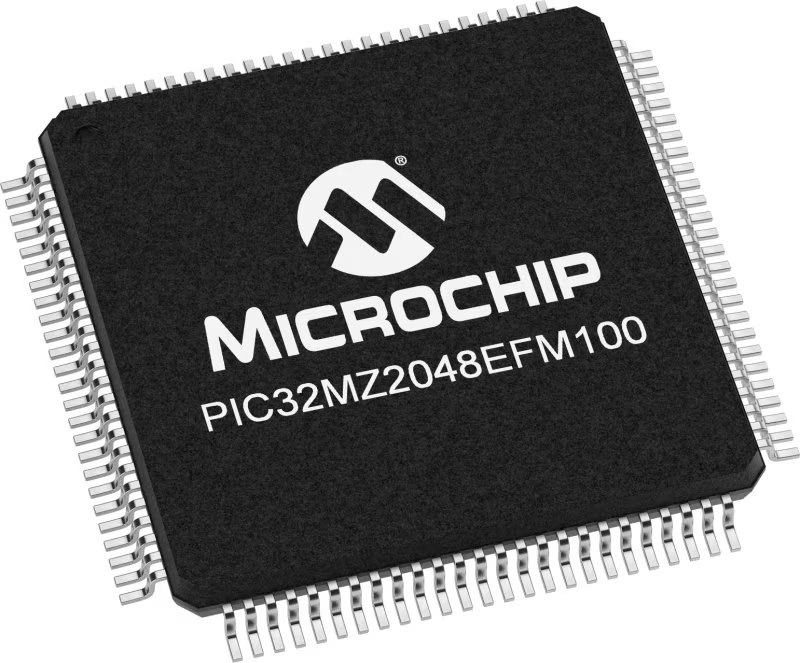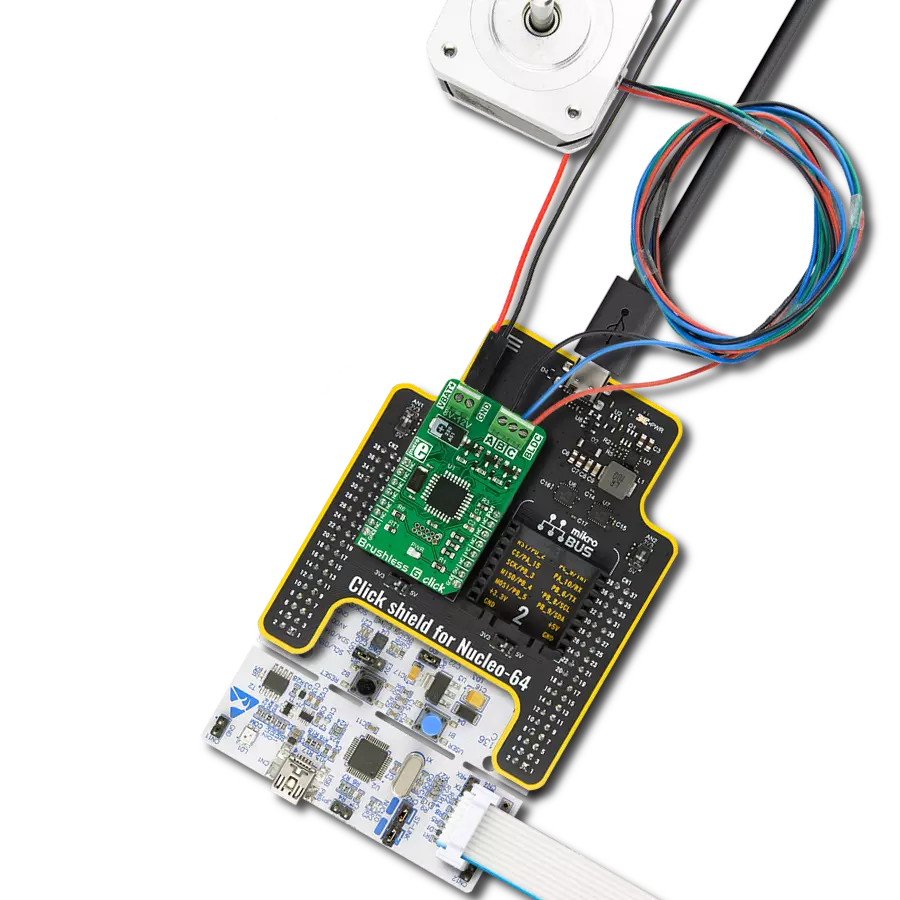Optimize the performance of a BLDC motor with precise control over the flow of electrical power
A
A
Hardware Overview
How does it work?
Brushless 27 Click is based on the TMC6300, a power driver for BLDC/PMSM motors from Analog Devices. It integrates a charge pump and ultra-low standby current, ensuring the best efficiency and longest battery life. The 3-phase driver offers three half-bridges with individual enable signals for low-side and high-side. It is optimized for BLDC motor control, as well as control of other magnetic actuators. Each MOSFET of each half-bridge can be individually switched on and off. Internal break-before-make (BBM) logic ensures that no cross-conduction occurs. The driver operates a BLDC motor with a block or sine-commutation using 6-line control from the PCA9538, a low-voltage
8-bit I/O port from NXP. The foot-points of the motor driver are connected via a sense resistor to the LMV321, a low-voltage rail-to-rail output operational amplifier from Texas Instruments. This OP-AMP allows current measurement of the motor to control or limit motor torque. You can change this sense resistor (R9) to set other maximum motor current values according to the table at the bottom of the Brushless 27 Click. The external power supply in a range of 2 – 11V can be connected over the INPUT screw terminal. Brushless 27 Click uses a standard 2-wire I2C interface of the PCA9538 to communicate with the host MCU, supporting clock frequency of up to
400kHz. The I2C address can be selected over the ADDR SEL jumpers. The I/O prot can be reset over the RST pin, while the host MCU can measure the current over the SEN pin. The diagnostic output signals any overcurrent or overtemperature condition over the INT pin. This Click board™ can operate with either 3.3V or 5V logic voltage levels selected via the VCC SEL jumper. This way, both 3.3V and 5V capable MCUs can use the communication lines properly. Also, this Click board™ comes equipped with a library containing easy-to-use functions and an example code that can be used for further development.
Features overview
Development board
Curiosity PIC32 MZ EF development board is a fully integrated 32-bit development platform featuring the high-performance PIC32MZ EF Series (PIC32MZ2048EFM) that has a 2MB Flash, 512KB RAM, integrated FPU, Crypto accelerator, and excellent connectivity options. It includes an integrated programmer and debugger, requiring no additional hardware. Users can expand
functionality through MIKROE mikroBUS™ Click™ adapter boards, add Ethernet connectivity with the Microchip PHY daughter board, add WiFi connectivity capability using the Microchip expansions boards, and add audio input and output capability with Microchip audio daughter boards. These boards are fully integrated into PIC32’s powerful software framework, MPLAB Harmony,
which provides a flexible and modular interface to application development a rich set of inter-operable software stacks (TCP-IP, USB), and easy-to-use features. The Curiosity PIC32 MZ EF development board offers expansion capabilities making it an excellent choice for a rapid prototyping board in Connectivity, IOT, and general-purpose applications.
Microcontroller Overview
MCU Card / MCU

Architecture
PIC32
MCU Memory (KB)
2048
Silicon Vendor
Microchip
Pin count
100
RAM (Bytes)
524288
You complete me!
Accessories
Brushless DC (BLDC) Motor with a Hall sensor represents a high-performance motor from the 42BLF motor series. This motor, wired in a star configuration, boasts a Hall Effect angle of 120°, ensuring precise and reliable performance. With a compact motor length of 47mm and a lightweight design tipping the scales at just 0.29kg, this BLDC motor is engineered to meet your needs. Operating flawlessly at a voltage rating of 24VDC and a speed range of 4000 ± 10% RPM, this motor offers consistent and dependable power. It excels in a normal operational temperature range from -20 to +50°C, maintaining efficiency with a rated current of 1.9A. Also, this product seamlessly integrates with all Brushless Click boards™ and those that require BLDC motors with Hall sensors.
Used MCU Pins
mikroBUS™ mapper
Take a closer look
Click board™ Schematic

Step by step
Project assembly
Track your results in real time
Application Output
1. Application Output - In Debug mode, the 'Application Output' window enables real-time data monitoring, offering direct insight into execution results. Ensure proper data display by configuring the environment correctly using the provided tutorial.

2. UART Terminal - Use the UART Terminal to monitor data transmission via a USB to UART converter, allowing direct communication between the Click board™ and your development system. Configure the baud rate and other serial settings according to your project's requirements to ensure proper functionality. For step-by-step setup instructions, refer to the provided tutorial.

3. Plot Output - The Plot feature offers a powerful way to visualize real-time sensor data, enabling trend analysis, debugging, and comparison of multiple data points. To set it up correctly, follow the provided tutorial, which includes a step-by-step example of using the Plot feature to display Click board™ readings. To use the Plot feature in your code, use the function: plot(*insert_graph_name*, variable_name);. This is a general format, and it is up to the user to replace 'insert_graph_name' with the actual graph name and 'variable_name' with the parameter to be displayed.

Software Support
Library Description
This library contains API for Brushless 27 Click driver.
Key functions:
brushless27_set_pins- Brushless 27 set pins function.brushless27_set_trap_com_state- Brushless 27 set trapezoidal com state function.brushless27_drive_motor- Brushless 27 drive motor function.
Open Source
Code example
The complete application code and a ready-to-use project are available through the NECTO Studio Package Manager for direct installation in the NECTO Studio. The application code can also be found on the MIKROE GitHub account.
/*!
* @file main.c
* @brief Brushless 27 Click example
*
* # Description
* This example demonstrates the use of the Brushless 27 click board by driving the
* motor in both directions at different speeds.
*
* The demo application is composed of two sections :
*
* ## Application Init
* Initializes the driver and performs the click default configuration.
*
* ## Application Task
* Drives the motor in both directions and changes the motor speed approximately every 2 seconds.
* The driving direction and speed will be displayed on the USB UART.
*
* @author Stefan Ilic
*
*/
#include "board.h"
#include "log.h"
#include "brushless27.h"
static brushless27_t brushless27;
static log_t logger;
void application_init ( void )
{
log_cfg_t log_cfg; /**< Logger config object. */
brushless27_cfg_t brushless27_cfg; /**< Click config object. */
/**
* Logger initialization.
* Default baud rate: 115200
* Default log level: LOG_LEVEL_DEBUG
* @note If USB_UART_RX and USB_UART_TX
* are defined as HAL_PIN_NC, you will
* need to define them manually for log to work.
* See @b LOG_MAP_USB_UART macro definition for detailed explanation.
*/
LOG_MAP_USB_UART( log_cfg );
log_init( &logger, &log_cfg );
log_info( &logger, " Application Init " );
// Click initialization.
brushless27_cfg_setup( &brushless27_cfg );
BRUSHLESS27_MAP_MIKROBUS( brushless27_cfg, MIKROBUS_1 );
if ( I2C_MASTER_ERROR == brushless27_init( &brushless27, &brushless27_cfg ) )
{
log_error( &logger, " Communication init." );
for ( ; ; );
}
if ( BRUSHLESS27_ERROR == brushless27_default_cfg ( &brushless27 ) )
{
log_error( &logger, " Default configuration." );
for ( ; ; );
}
log_info( &logger, " Application Task " );
}
void application_task ( void )
{
log_printf ( &logger, "\r\n Driving motor clockwise \r\n" );
for ( uint8_t speed = BRUSHLESS27_SPEED_MIN; speed <= BRUSHLESS27_SPEED_MAX; speed += 20 )
{
log_printf ( &logger, " Speed gain: %u\r\n", ( uint16_t ) speed );
if ( BRUSHLESS27_OK != brushless27_drive_motor ( &brushless27, BRUSHLESS27_DIR_CW, speed, 2000 ) )
{
log_error ( &logger, " Drive motor " );
}
}
Delay_ms ( 1000 );
log_printf ( &logger, "\r\n Driving motor counter-clockwise \r\n" );
for ( uint8_t speed = BRUSHLESS27_SPEED_MIN; speed <= BRUSHLESS27_SPEED_MAX; speed += 20 )
{
log_printf ( &logger, " Speed gain: %u\r\n", ( uint16_t ) speed );
if ( BRUSHLESS27_OK != brushless27_drive_motor ( &brushless27, BRUSHLESS27_DIR_CCW, speed, 2000 ) )
{
log_error ( &logger, " Drive motor " );
}
}
Delay_ms ( 1000 );
}
int main ( void )
{
application_init( );
for ( ; ; )
{
application_task( );
}
return 0;
}
// ------------------------------------------------------------------------ END

































